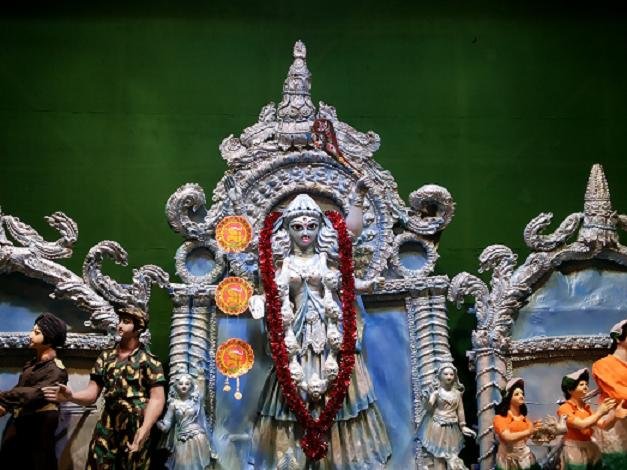The pandal near Madhyamgram Railway Station was a sight to behold this Pujo season. I was thoroughly impressed by the intricate detailing and thematic brilliance on display. Every year, I find it challenging to navigate through the bustling crowds to enter this pandal, often resorting to capturing photos from the outside. However, this time, I was pleasantly surprised to find a relatively empty path leading to it, even as the clock struck twelve in the night. With ample time on my hands, I decided to explore every nook and cranny, and I must say, it was quite an experience.
This year, the pandal boasted two distinct themes. The exterior was adorned with the "Rajasthan's Shri Krishna Rasleela Theme," while the interior, or the pujo mandap, was themed "Kalikrishna." The entire pandal was crafted to resemble a traditional Rajasthan mansion, complete with its characteristic architectural features. The structure was surrounded by a five-tiered boundary wall made of clay or stone, reminiscent of the compounds of Rajasthan homes. Intricate motifs adorned every inch of these walls, depicting various scenes and symbols of Rajasthan's cultural heritage.
As I passed through the gate, a magnificent tableau unfolded before my eyes. Large, life-sized statues of camels were stationed at various points, symbolizing the importance of these animals in Rajasthan's culture. In the center of it all, a mechanized display showcased a scene from Shri Krishna's childhood, with the deity depicted as a mischievous child stealing butter from a clay pot, while Mother Yashoda looked on with a mixture of exasperation and affection. Surrounding this tableau, lifelike statues of gopis danced in joy, their colorful attire adding to the festive ambiance.
Tanuja, my friend, took a few photos with the camel statues before we proceeded to the main pujo mandap. The mandap, shaped like a dome, featured intricate carvings and decorations reminiscent of Rajasthan's architectural style. Surrounding the central area where the deity was worshipped, various robotic displays showcased scenes from Krishna's life, such as his birth, the killing of Kansa, the theft of butter, and the conquering of Kaliya. Each display was meticulously crafted, capturing the essence of these legendary tales with remarkable detail and precision.
When Kali appeared as Krishna, her face was not fierce but serene, her tongue not bloodthirsty but graceful, and her presence exuded a sense of undeniable beauty. This juxtaposition of Kali and Krishna in the same tableau was something I had never witnessed before.
